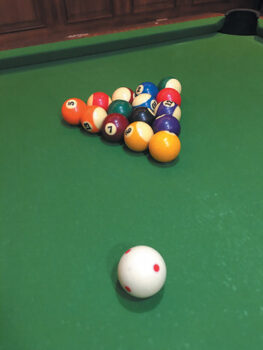 Johnny Henson and Steve Farmer
Johnny Henson and Steve Farmer
Most pool players never figure out that there is a big difference between practice and playing. I had a player come to me for instruction, and he said that he practices 2 to 4 hours a day but he never seems to improve his game or his skill level. Banging balls around for hours without any true focused practice goals is a mistake that most players make when it comes to their practice session. One hour of focused practice will improve your game more than 4 hours of playing, or as I call it, banging balls around. Top-level players are serious and focused when it comes to their practice time. Most players usually start with a few easy shots, a few cut shots, a few long shots, and a few banks. Then they are ready to play! That is not how quality practice works.
An example of a quality practice routine might be working on just the stroke for 10 to 15 minutes, as 70% to 75% of all your missed shots are due to a poor stroke. You should practice long shots, mid-range shots, thin cut shots, long banks, cross banks, or any shots you know you have trouble with when you are competing.
We recommend that students shoot shots in sets of 10 shots. This way they can give each shot a percentage. For example, in 10 bank shots, if you made 4 and missed 6 your percentage for bank shots is 40%. By always noting your percentage, you will know if you’re improving. Most importantly, if you can shoot a shot 80% of the time in practice, when competing, you will have more confidence in that shot when you shoot it.
We also encourage every player to note every miss they have when competing. You need to shoot at least 10 of each one of those shots in your next practice session. Focusing on shots you miss when you’re practicing makes more sense, than shooting easy shots you already know you can make consistently. When Johnny was a tournament player he would note every shot he missed. In his next practice session, he would shoot every shot until he either made the shot 10 times in a row or 30 total attempts. If he missed a real easy shot due to lack of focus, he would shoot that shot the next practice 30 times as a punishment. Sometimes he would have an easy 8 ball or 9 ball, and would stop to ask himself, “Do you want to focus on this shot, or do you want to shoot it 30 times tomorrow?” This really helped him focus and not take easy shots for granted when competing.
Be focused during practice, reflecting the way you normally play as much as possible. We recommend that you do your pre-shot routine. If you want to take your game to the next level, the true practice to competing ratio should be at least 5 to 1. Willie Moscon’s was 40 to 1. Many top professionals on tour are at least 20 to 30 to 1. You don’t have to get that carried away, but the larger your ratio is, will prove to you how serious you are at improving your game. I hope this helps you.
Johnny Henson, Professor Pool, and Steve Farmer are both Professional Billiards Instructors Association (PBIA) and American Cue Sports (ACS) certified instructors. If you have questions, call 623-377-0042 or visit our website at BilliardUniversity.com.
